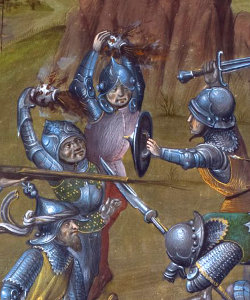 Fire and Lime Pots were simple bulbous ceramic jars, sometimes common utilitarian pottery, with a semi-wide opening and a pronounced throat below the rim. Depending on the purpose, these were filled with explosives, fire accelerants or with quicklime and caltrops.
Fire and Lime Pots were simple bulbous ceramic jars, sometimes common utilitarian pottery, with a semi-wide opening and a pronounced throat below the rim. Depending on the purpose, these were filled with explosives, fire accelerants or with quicklime and caltrops.
The vessel's mouth was sealed with a piece of cloth and a band around the neck of the vessel. In the first case, they could be thrown at the opponent by hand, with ropes or mechanical slings.1) This type of weapon can be used for a wide variety of purposes with the appropriate fillings, and the authors of historical military manuals provide a great wealth of suggestions for recipes and applications here. Here is a small selection:
Fire Pots
Incendiary charges are among the oldest and simplest forms of storm pots. These were filled with easily combustible substances such as pitch, turpentine, ethyl alcohol, sulphur, saltpetre or naphtha. The first written references to their use date back to the 8th/7th century BC from Mesopotamia. Around 1280, they are described by the Arab author Hassan Al-Rammah in his war book. In Europe, they are mentioned by Marcus Graecus around 1260 and by Konrad Kyeser around 1405. They were used in practice, for example, in the siege of Acre (Israel) by the Crusaders in 1190 or in the siege of Brzung (Brzeg, German name Brieg, in Silesia, Poland?) by the Teutonic Order in 1331/32.2) A wide variety of recipes and instructions for incendiary charges have been handed down from historical literature; the following are some examples:
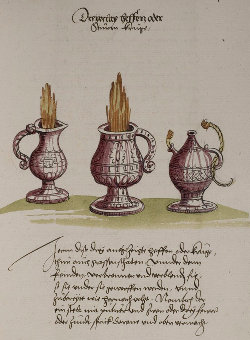 The vessel filling for a possible sticking fire consists of a paste of black powder, sulphur, pitch and resin in the lower two thirds and black powder in the upper third. The opening of the vessel is sealed with a tarred or pimped linen cloth. Fuse cords are attached to the handles. In an emergency, the sealing cloth is torn open, the fuses are lit and the vessel is hurled at the enemy. There it breaks and the sticky contents that escape are ignited by the smouldering fuses..3)
The vessel filling for a possible sticking fire consists of a paste of black powder, sulphur, pitch and resin in the lower two thirds and black powder in the upper third. The opening of the vessel is sealed with a tarred or pimped linen cloth. Fuse cords are attached to the handles. In an emergency, the sealing cloth is torn open, the fuses are lit and the vessel is hurled at the enemy. There it breaks and the sticky contents that escape are ignited by the smouldering fuses..3)
- Half of the vessel filling consists of a dry mixture of black powder, rosin and sulphur, the upper half is filled with lard. Before throwing, a hole is pierced through the layer of lard in the powder charge, a fuse is inserted and ignited. When the fuse burns well, the vessel is hurled at the opponent..4) The black powder explodes, finely dispersing and igniting the fat in a wide radius.
- A mixture of lard, petroleum, sulphur oil, sulphur, saltpetre, rosin, turpentine and some black powder is mixed in a kettle and poured into the storm vessel. A layer of black powder is placed on top. The vessel must then stand still for some time.4)
Explosive Pots
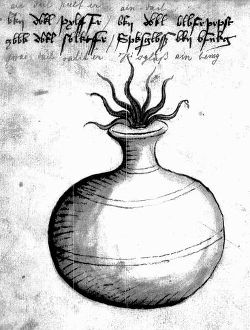 Explosive charges became possible with the invention of black powder. The main effect of the explosive pots was the explosive spread of the burning contents. In contrast to grenades, however, the splintering effect of the container pots was still in the background. In the following, we would like to briefly present two different recipes from historical literature.:
Explosive charges became possible with the invention of black powder. The main effect of the explosive pots was the explosive spread of the burning contents. In contrast to grenades, however, the splintering effect of the container pots was still in the background. In the following, we would like to briefly present two different recipes from historical literature.:
- The ceramic pot is filled with black powder to just below the opening and the opening is sealed with flour paste. Fuse cords are tied to the handles. In an emergency, the fuses are ignited and the pot is thrown.5) After impact, the powder escaping from the broken vessel is ignited by the smouldering fuses and burns abruptly with a large jet flame
- A thick-walled ceramic pot is filled up to the neck with a mixture of powder, sulphur, saltpetre, glass fragments and lead powder, on top of which a layer of black powder is added. The filling is then compacted hard and the opening is sealed with a piqued cloth..3) Before use, the cloth is pierced and a fuse is inserted into the filling. After the fuse is lit, the vessel is hurled at the opponent where it explodes.
Lime Pots
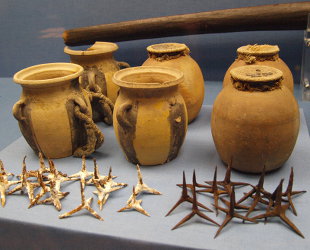 Assault pots with dazzling charges are used to hinder or disable opponents by blinding them. Preserved originals from the former Zurich Ketzerturm (Swiss)6) and the Zurich Lindenhof-Quarter7), now in the Swiss National Museum in Zurich, or specimens in the art collections of the Veste Coburg contain fillings of quicklime and caltrops. Or they are filled with Spanish pepper as a dazzling agent, just like some surviving storm pots from the Dutch town of Vlissingen.8)In battle, the vessels are hurled at the besiegers, they break and the escaping lime corrodes the opponents' eyes, respiratory tract and skin. In addition, the blinded fighters also kick their feet with the caltrops.1)
Assault pots with dazzling charges are used to hinder or disable opponents by blinding them. Preserved originals from the former Zurich Ketzerturm (Swiss)6) and the Zurich Lindenhof-Quarter7), now in the Swiss National Museum in Zurich, or specimens in the art collections of the Veste Coburg contain fillings of quicklime and caltrops. Or they are filled with Spanish pepper as a dazzling agent, just like some surviving storm pots from the Dutch town of Vlissingen.8)In battle, the vessels are hurled at the besiegers, they break and the escaping lime corrodes the opponents' eyes, respiratory tract and skin. In addition, the blinded fighters also kick their feet with the caltrops.1)
During the siege of Zurich by the Confederates, the city's defenders successfully used dazzle pots on 25 July 1444, as the chronicler Gerold Edlibach described impressively:
„… da hattend sy vil Häfen und Krüg gemacht von Herd [Erde] und die gefüllt mit Kalch und wurfend die unter die Eidgnossen, dass es ein sömliches [grosses] Gestäub ward, dass die Eidgnossen schier erstickt warend und pfuchseten wie pfiffige Hüner [wie piepsige Hühner husteten] zu dem und einer den andern von grossem Staub nit wol sehen mocht und also tribend die Züricher die Eidgnossen mit Geschütz und anderer Gewehr von der Statt.”6)
(... then they had made many pots and jars of earth and filled them with calf and threw them among the Confederates, so that it became a great dust, that the Confederates were almost suffocated, and they foxed like squeaking chickens to that one, and one did not like to see the other with great dust, and so the citizens of Zurich attacked the Confederates with guns and other weapons from the city.)
A few years younger is a mention in the travel diary of the philosopher and physician Hieronymus von Nürnberg from 1498, according to which the city of Ceuta, held by Don Alfonso V. (named "the African"), was defended with lime pots against the Saracens with lime pots on the orders of the knight Georg von Ramseidner: „Ramseidner Georgius autem suo ingenio amphoras ex limo semiusto faciens et eas calce pulverizata et ferreis triangulis quos Fusseisen vocant implens foras muros in mediam Saracenorum turrem jeeit. Excæcati autem aut vulnerati Saraceni magna damna sustulerunt.” He had half-baked earthenware pots filled with powdered quicklime and caltrops and thrown into the Saracen siege tower, which played so badly with the besiegers that they had to give up the siege and retreat because of blindness and wounds.6)9)
Grenade Pots
Here the filling corresponds to the recipes for explosive pots with additionally embedded grenades. The grenades are ignited by the exploding pot filling and hurled away, which in turn explode in the wider radius of the point of impact.1)
Stink Pots
The vessel fillings of skunk pots consist of a mixture of black powder, saltpetre, charcoal, fine pitch, spit shine (antimony), sulphur, as well as horse hoof and goat horn shavings, pig bristles, devil's dung (asafoetida, Asa fœtida), black cohosh (bugbane, Actaea racemosa) or other substances.9) The stink pots were ignited and thrown at the opponent, where the contents ignited and burned aggressively with strong smoke and smell. The unpleasant stench of the burning asa fœtida unsettled enemy fighters. The burning horn in particular had a strongly disturbing effect on horses and triggered deep-rooted flight impulses in them:1) The horses running through in panic further contributed to the confusion of the enemy and could cause considerable damage.
Another, simpler approach is described by the author of the Wolfegg house book of 1483: "Ein gestanck zu werffen. Nym mylch wasser von kesen vnd harn dar vnder vnd mach daz yn fleschen do kein lufft zu komen möge es zehen tag oder lenger ligen vnd werffs es mag vor gestang niemans dar by blibenn." (To throw a stanck. Take milk water from cheese and urine to it and fill it into bottles so that no air can get to it let it lie ten days or longer and throw it may from stink no one stay there).10)
Poison Pots
In addition to the aforementioned fillings, some authors mention in their works poison pots to whose fire mixtures arsenic, mercury or other toxic substances were added.8) Some authors recommend the admixture of further substances in their recipes which were considered harmful or poisonous for humans and animals according to contemporary alchemical knowledge. However, according to current scientific assessment, most of these substances have no particularly short-term acute efficacy.11)
Reconstructions
Lime Pots
 Our reconstruction proposals are based on the originals from the collections of the Veste Coburg and the Swiss National Museum in Zurich.12) They consist of brown and grey, hard-fired earthenware. The blind pot, left open for presentation purposes, contains a charge of finely painted etched lime and iron caltrops. The height of the pot is 180 mm, the diameter 170 mm, with a weight of 4,300 g. Another storm pot was sealed with a piece of canvas that was tied and knotted around the neck of the vessel.
Our reconstruction proposals are based on the originals from the collections of the Veste Coburg and the Swiss National Museum in Zurich.12) They consist of brown and grey, hard-fired earthenware. The blind pot, left open for presentation purposes, contains a charge of finely painted etched lime and iron caltrops. The height of the pot is 180 mm, the diameter 170 mm, with a weight of 4,300 g. Another storm pot was sealed with a piece of canvas that was tied and knotted around the neck of the vessel.  The sealing canvas and the winding were sealed with linseed oil. This pot can stand as an example of various possibilities, such as a dazzle pot, incendiary pot, blast pot or stink pot. The height of this pot is 165 mm, the diameter 155 mm and its weight about 3,100 g.
The sealing canvas and the winding were sealed with linseed oil. This pot can stand as an example of various possibilities, such as a dazzle pot, incendiary pot, blast pot or stink pot. The height of this pot is 165 mm, the diameter 155 mm and its weight about 3,100 g.
The storage of storm pots with a filling of quicklime can prove to be problematic under certain circumstances. In one of our reconstructions, the lime filling had absorbed moisture from the air and its increased volume had burst the ceramic pot.
Fire Pots (Sturmhäferl)
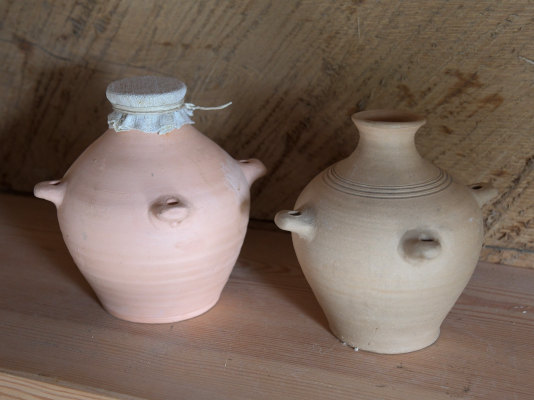 The reconstruction of the fire pots corresponds to the finds from the Styrian fortress Weitschawar near Bajcsa-Vár near the Hungarian town of Nagykanizsa, which was abandoned in 1609. The fortress, built in 1578, was equipped with weapons and implements from the Landeszeughaus Graz. The fire pots were discovered during excavations in 1998 and 1999. As entries in the inventories of the Graz State Armoury show, these fire pots were from Styrian production, and delivered to the Weitschawar fortress in numerous shipments of several hundred pieces each.13) The vessels had a base diameter of 60–65 mm and heights of 110–117 mm, the volume of a completely preserved vessel is 425 ccm. These ceramic vessels were special productions for purely military purposes that have no parallels in the other ceramic forms of their time..14) Our vessels have volumes between 256 and 422 cc. We have had another set of vessels reconstructed from a number of originals, which are relatively uniform in shape and size despite different places of origin and dating. These are finds from Vlissingen (The Neterhalnds)8) which are dated by the Rijksmuseum Amsterdam to the period between 1550-170015), the ship wreck La Trinidad Valencera of the Spanish Armada dated 1588, the Portuguese warship that sank in the port of Mombasa in 1697 Santo Antonio de Tanna16) or from Corfe Castle in Dorset, associated with the English Civil War 1642–164917). This form of storm pots is found, for example, in Diego Ufano's Tratado dela artilleria y uso della platicado por el capitan Diego Ufano en las guerras de Flandes von 1617.18) These vessels have volumes from 282 to 317 ccm.
The reconstruction of the fire pots corresponds to the finds from the Styrian fortress Weitschawar near Bajcsa-Vár near the Hungarian town of Nagykanizsa, which was abandoned in 1609. The fortress, built in 1578, was equipped with weapons and implements from the Landeszeughaus Graz. The fire pots were discovered during excavations in 1998 and 1999. As entries in the inventories of the Graz State Armoury show, these fire pots were from Styrian production, and delivered to the Weitschawar fortress in numerous shipments of several hundred pieces each.13) The vessels had a base diameter of 60–65 mm and heights of 110–117 mm, the volume of a completely preserved vessel is 425 ccm. These ceramic vessels were special productions for purely military purposes that have no parallels in the other ceramic forms of their time..14) Our vessels have volumes between 256 and 422 cc. We have had another set of vessels reconstructed from a number of originals, which are relatively uniform in shape and size despite different places of origin and dating. These are finds from Vlissingen (The Neterhalnds)8) which are dated by the Rijksmuseum Amsterdam to the period between 1550-170015), the ship wreck La Trinidad Valencera of the Spanish Armada dated 1588, the Portuguese warship that sank in the port of Mombasa in 1697 Santo Antonio de Tanna16) or from Corfe Castle in Dorset, associated with the English Civil War 1642–164917). This form of storm pots is found, for example, in Diego Ufano's Tratado dela artilleria y uso della platicado por el capitan Diego Ufano en las guerras de Flandes von 1617.18) These vessels have volumes from 282 to 317 ccm.
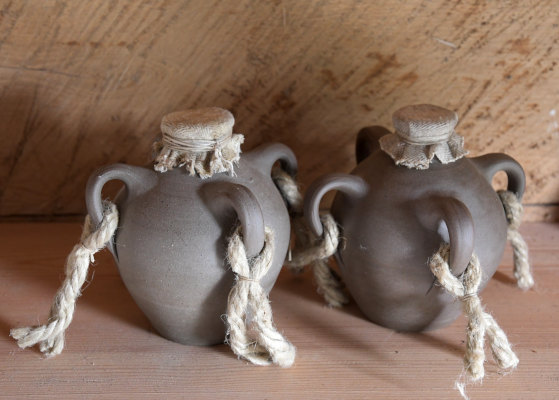
Reconstructions after originals from Vlissingen (NL), or Corfe Castle (UK), almost identical storm pots are also preserved from the Spanish shipwreck Antonio de Tanna from 1588..
References
- Geibig (2012): pp. 31–46
- Mielke (1982). (Mielke does not give a more precise explanation for the place name Brzung. We assume the town of Brzegt in the Polish voivodeship of Lower Silesia).
- Brrantz, Boillot (1603): p. 150
- Biringuccio (1540)
- Franz Helm (1535)
- Keller (1871)
- Schnyder (1971), pp. 193–194
- Bijdrage over de zoogenoemde Vuurpotten, ook wel beken onder den manam van Storm– en Stankpotten. (1857)
- Harder (1867), p. 41
- sog. Mittelalterliche Hausbuch Schloss Wolfegg (1483), Fol. 59v
- Courtesy of Dr Alfred Geibig, Kunstsammlungen der Veste Coburg, Germany
- Aus dem Zürcher Ketzerturm, 15. Jh., Swiss National Miuseum Zurich, Inv. No AG 905
- Kramer (2005): pp. 55–61; Kovács (2001)
- Kramer (2005): pp. 87–88, 191
- Aardenwerken vuurpot, Rijksmuseum Amsterdam, Inv. Nr. NG–MC–945-A, -B, -C
- Martin (1994).
- Mepham (2012).
- Ufano (1617): table F.374
Text and photos: Andreas Franzkowiak
